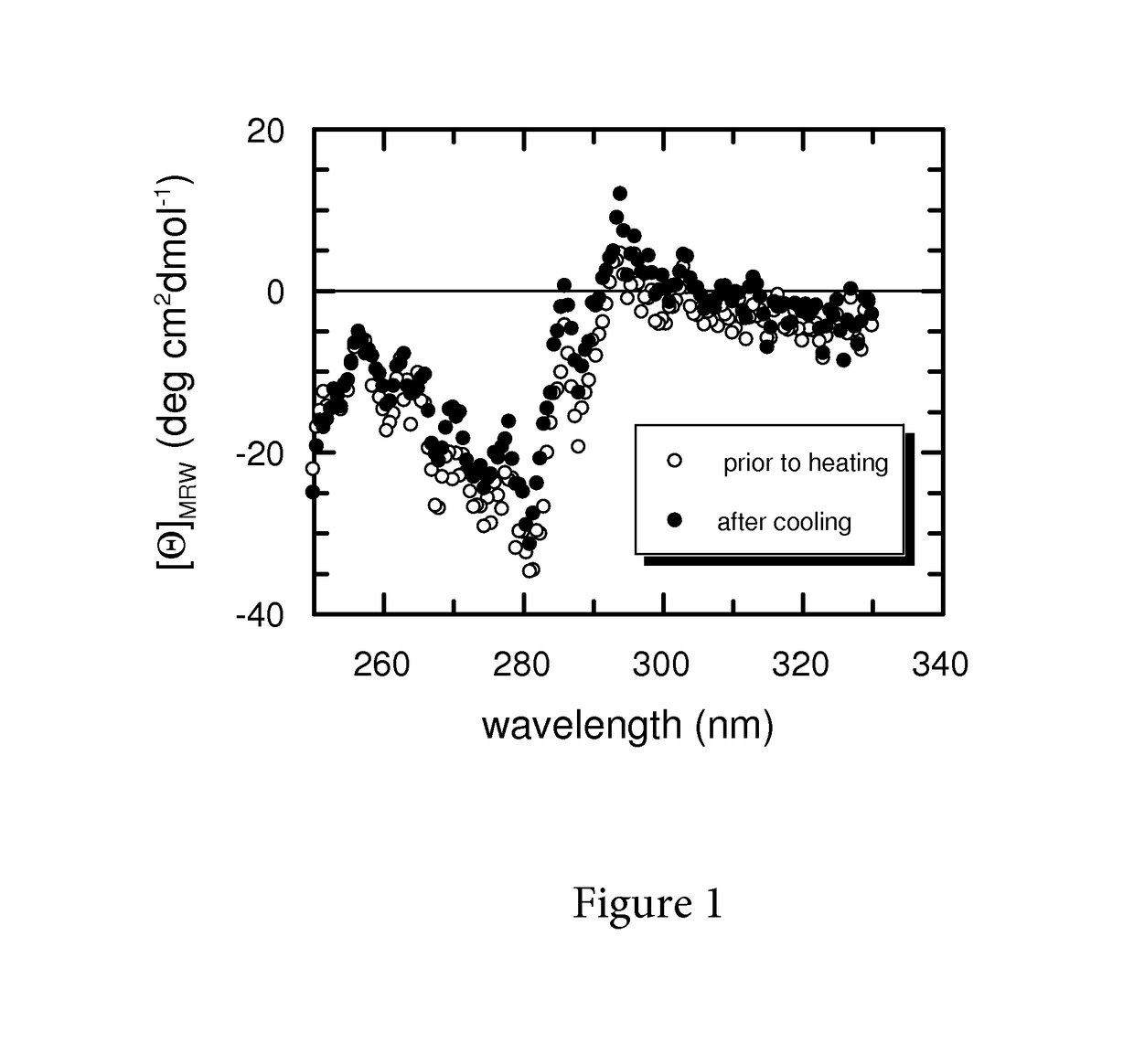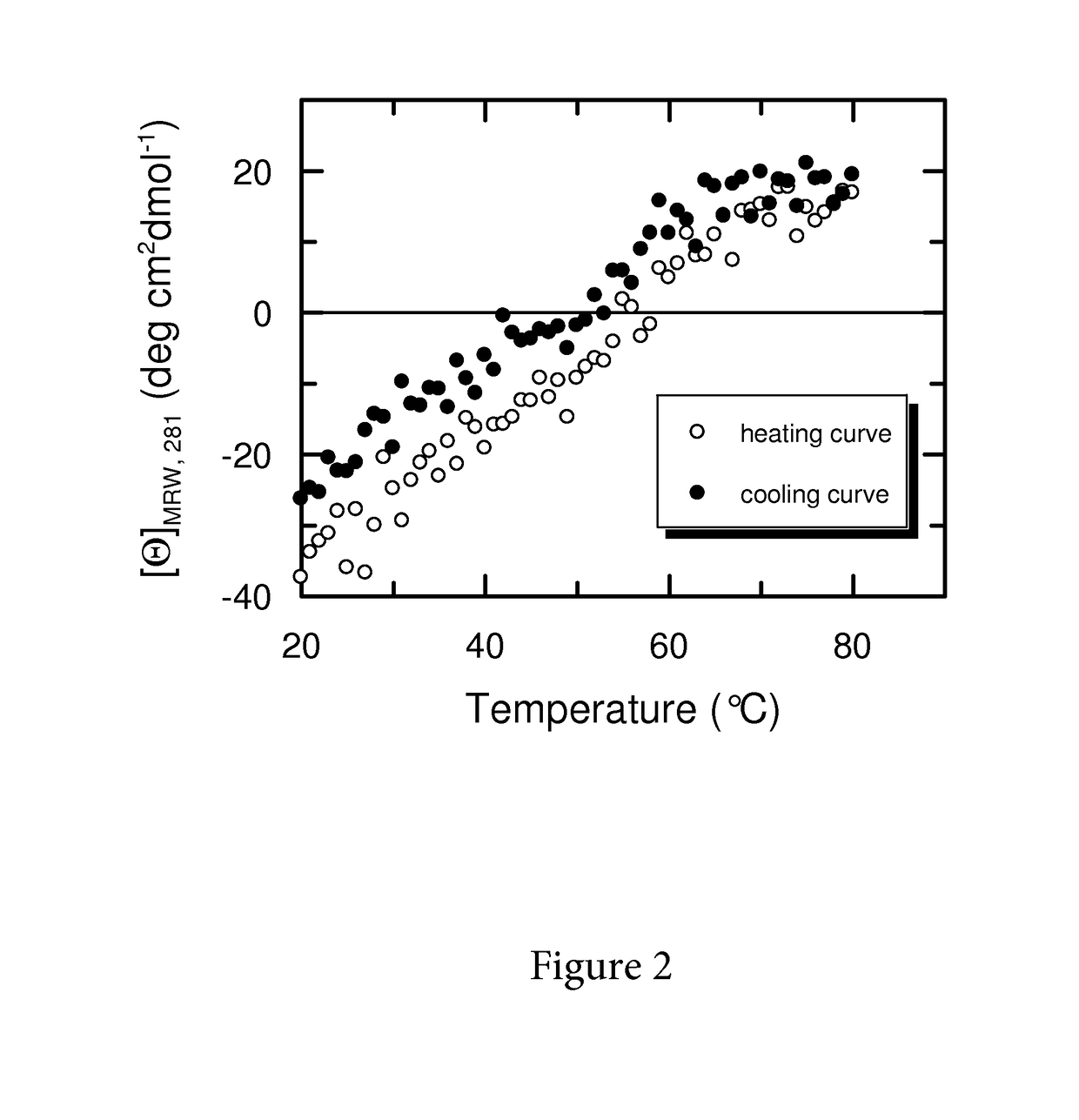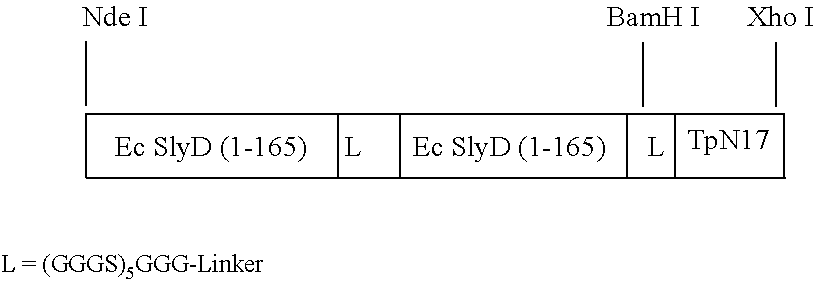Vibrio cholerae lipoprotein 15 (Lp15) variants as anti-interference additive in TpN17-based immunoassays for detection of anti-Treponema antibodies
a lipoprotein and anti-interference technology, applied in the field of vibrio cholerae /i > lipoprotein 15 (lp15) variants as anti-interference additive in tpn17-based immunoassays for detection of anti-treponema /i > antibodies, can solve the problems that immunoassays using tpn17 as an antigen tend to show false positive results, and the importance of syphilis remains
- Summary
- Abstract
- Description
- Claims
- Application Information
AI Technical Summary
Benefits of technology
Problems solved by technology
Method used
Image
Examples
example 1
Cloning and Purification of TpN17 and VcLp15 Chaperone Fusion Polypeptides
Cloning of Expression Cassettes
[0071]On the basis of the pET24a expression plasmid of Novagen (Madison, Wis., USA), expression cassettes encoding TpN17 and VcLp15 fusion proteins were obtained essentially as described (Scholz, C. et al., J. Mol. Biol. (2005) 345, 1229-1241). The sequences of the TpN17 and VcLp15 antigens were retrieved from the SwissProt database (SwissProt ID P29722 and Q9KQN6, respectively). A synthetic gene encoding mature TpN17 aa 23-156 (the signal peptide spanning amino acid residues 1-22 was omitted) with a glycine-rich linker region fused in frame to the N-terminus was purchased from Medigenomix (Martinsried, Germany). The cysteine residues of TpN17 at positions 25, 29, 42 and 58 were changed to alanine residues in order to prevent unwanted side-effects such as oxidation or intermolecular disulfide bridging. BamHI and XhoI restriction sites were at the 5′ and the 3′ ends of the TpN17-c...
example 2
Spectroscopic Measurements
[0078]Protein concentration measurements were performed with an Uvikon XL double-beam spectrophotometer. The molar extinction coefficients (ε280) were determined by using the procedure described by Pace (1995), Protein Sci. 4, 2411-2423. The molar extinction coefficients (εM280) used for the distinct fusion polypeptides are specified in table 1.
[0079]
TABLE 1Protein parameters of the fusion polypeptide variantsused in this study. All parameters are referring to therespective protein monomers.length ofmoleculartargetweight ofproteinfusionAbs0.1%(aapolypeptideεM280(=1 mg / fusion proteinresidues)(Da)pIM−1cm−1ml)TpN17 variantsEcSlyD-EcSlyD-23-156540485.0233800.433TpN17PmSlyD-PmSlyD-23-156521714.9233800.448TpN17EcFkpA-TpN1723-156429958.3273900.637EcSkp-TpN1723-156324619.3129500.399VcLp15 variantsEcSlyD-VcLp1526-163351564.6229200.652EcSkp-VcLp1526-163330105.3184500.559
[0080]The amino acid sequences of the fusion polypeptide variants are shown in SEQ ID NOs. 3, 4, 8...
example 3
Coupling of Biotin and Ruthenium Moieties to the TpN17 Fusion Proteins
[0081]The lysine ε-amino groups of the TpN17 fusion polypeptides were modified at protein concentrations of 10-30 mg / ml with N-hydroxy-succinimide activated biotin and ruthenium label molecules, respectively. The label / protein ratio varied from 2:1 to 5:1 (mol:mol), depending on the respective fusion protein. The reaction buffer was 150 mM potassium phosphate pH 8.0, 100 mM KCl, 0.5 mM EDTA. The reaction was carried out at room temperature for 15 mM and stopped by adding buffered L-lysine to a final concentration of 10 mM. To avoid hydrolytic inactivation of the labels, the respective stock solutions were prepared in dried DMSO (seccosoiv quality, Merck, Germany). DMSO concentrations up to 25% in the reaction buffer were well tolerated by all fusion proteins studied. After the coupling reaction, unreacted free label was removed by passing the crude protein conjugate over a gel filtration column (Superdex 200 HiLoa...
PUM
| Property | Measurement | Unit |
|---|---|---|
| pH | aaaaa | aaaaa |
| pH | aaaaa | aaaaa |
| concentrations | aaaaa | aaaaa |
Abstract
Description
Claims
Application Information
 Login to View More
Login to View More - R&D
- Intellectual Property
- Life Sciences
- Materials
- Tech Scout
- Unparalleled Data Quality
- Higher Quality Content
- 60% Fewer Hallucinations
Browse by: Latest US Patents, China's latest patents, Technical Efficacy Thesaurus, Application Domain, Technology Topic, Popular Technical Reports.
© 2025 PatSnap. All rights reserved.Legal|Privacy policy|Modern Slavery Act Transparency Statement|Sitemap|About US| Contact US: help@patsnap.com



